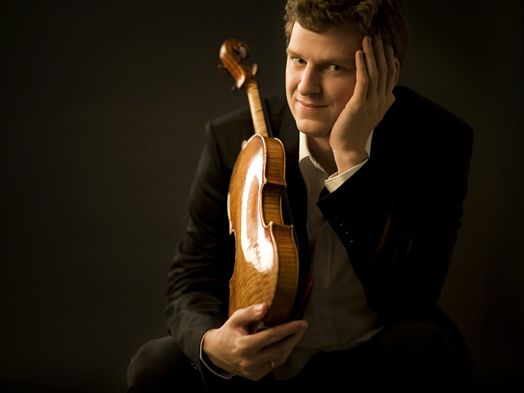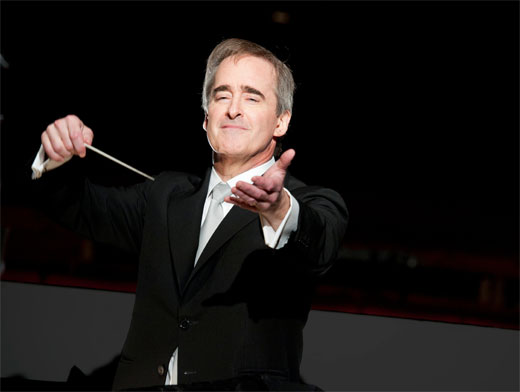Conlon, Ehnes and New World open new year with terrific Mahler and Mendelssohn

James Ehnes performed Mendelssohn with the New World Symphony Saturday night at the Arsht Center. Photo: Benjamin Ealovega
For all its popularity, Mendelssohn’s Violin Concerto can be a difficult work to bring off. Many violinists struggle to enter the concerto’s unique expressive world of grace, delicacy and Romantic emotional drama.
The Canadian violinist James Ehnes, who is become a frequent visitor to South Florida as both soloist and chamber player, gave a terrific performance of Mendelssohn’s concerto Saturday night at the Arsht Center in Miami with the New World Symphony led by guest conductor James Conlon.
Of Ehnes’ virtuosity, there was no question, and he played without a trace of effort to disturb the smooth surface. But beyond that he brought an early Romantic sensibility to the performance, playing in an expressive but compact manner that brought out the concerto’s youthful vulnerability and high spirits.
With a slender but singing tone, he phrased the plaintive opening melody with intensity and a touch of fragility, inflecting it in a manner that expressed its emotion without larding it with vibrato.
The violinist was assertive and vigorous but never rough in the rapid-fire passagework and brought a keen sense of drama to the cadenza, suddenly dropping the volume and raising the speed as he began a series of trills that led up to a climactic passage of chords and arpeggios.
The orchestra sounded a bit too loud at the opening of the Andante, which appeared to draw a more strident tone from Ehnes. But as the movement progressed, it led to one of the great moments of the performance, in a section in which the soloist plays both melody and accompaniment. In this dark minor-key melody, which climaxes with an ascent in octaves, Ehnes brought to the music a raw emotional intensity rarely heard in Mendelssohn but absolutely convincing in this passage. The last movement was a whirl of light, effortless virtuosity.
Rarely will an encore eclipse the main event, but Ehnes’ performance of the Allegro assai from Bach’s Sonata No. 3 for solo violin came close. Although the work never calls for playing on more than a single string at once, Ehnes played it with such brilliance, speed and dexterity. Most impressive was his overarching sense of structure, bringing out the polyphonic grandeur of Bach’s music, and showing why the composer’s solo violin works can still amaze after nearly 300 years.
After intermission, the concert continued with Mahler’s Symphony No. 1. Conlon, music director of the Los Angeles Opera and suburban Chicago’s Ravinia Festival, conducted without a score, leading a taut, exciting account in which the ending, with its triumphant brass theme, came off as a joyous catharsis.
The opening pages, with wind riffs over a long held note in the strings, was done with crisp dexterity and transparent resonance in the orchestra, bringing out the light and shadows of this invocation of nature. Conlon embraced the rustic streak that runs through the symphony. The second movement’s Ländler came off as a foot-stomping performance by an overgrown village band, which tidied up for the smoother, more polished Trio that followed.
Principal bass Tim Dilenschneider gave a dark, eerie performance of the solo that opens the third movement–a minor-key version of the song “Frère Jacques”– with great clarity and beauty of tone. Conlon led a long, masterly crescendo as the other instruments joined in.
Under Conlon’s baton, the last movement opened with the violence of an electrical storm, with frantic, wild passages in the strings and hammer blows by the brass. This was a harrowing performance, yet with Conlon exercised fine control over the brass, keeping them from burying the racing string notes that give the passage its diabolical edge. Violins shone in this movement, from the rapid passagework of the opening to the long, throbbing melody that took them high up their lowest string, an effect Mahler used to create a uniquely full and intense tone.
Toward the end of the movement, following Mahler’s instructions, the horns stood to blast out their final notes. Mahler wrote some of his most stirring music for horns, and New World’s section had a great night, playing with accuracy and style in passages that ranged from light and crisp, to smooth and soaring.
Posted in Performances
Leave a Comment
Sun Jan 11, 2015
at 1:00 pm
No Comments







